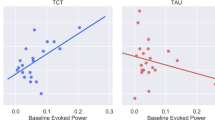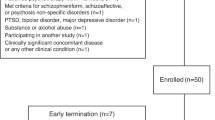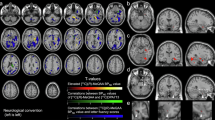Abstract
This exploratory trial was conducted to test the effects of an alpha7 nicotinic receptor partial agonist, TC-5619, on cognitive dysfunction and negative symptoms in subjects with schizophrenia. In the United States and India, 185 outpatients (18–60 years; male 69%; 46% tobacco users) with schizophrenia treated with quetiapine or risperidone monotherapy were randomized to 12 weeks of placebo (n=91) or TC-5619 (n=94; orally once daily 1 mg day 1 to week 4, 5 mg week 4 to 8, and 25 mg week 8 to 12). The primary efficacy outcome measure was the Groton Maze Learning Task (GMLT; executive function) of the CogState Schizophrenia Battery (CSB). Secondary outcome measures included: CSB composite score; Scale for Assessment of Negative Symptoms (SANS); Clinical Global Impression-Global Improvement (CGI-I); CGI-severity (CGI-S); and Subject Global Impression-Cognition. GMLT statistically favored TC-5619 (P=0.036) in this exploratory trial. SANS also statistically favored TC-5619 (P=0.030). No other secondary outcome measure demonstrated a drug effect in the total population; there was a statistically significant drug effect on working memory in tobacco users. The results were typically stronger in favor of TC-5619 in tobacco users and occasionally better in the United States than in India. TC-5619 was generally well tolerated with no clinically noteworthy safety findings. These results support the potential benefits of TC-5619 and alpha7 nicotinic receptor partial agonists for cognitive dysfunction and negative symptoms in schizophrenia.
Similar content being viewed by others
Log in or create a free account to read this content
Gain free access to this article, as well as selected content from this journal and more on nature.com
or
References
Addington J, Addington D (1993). Premorbid functioning, cognitive functioning, symptoms and outcome in schizophrenia. J Psychiatry Neurosci 18: 18–23.
American Psychiatric Association (2000) Diagnostic and Statistical Manual of Mental Disorders 4th edn, Text Revision edn American Psychiatric Association: Washington, DC.
Buchanan RW, Conley RR, Dickinson D, Ball MP, Feldman S, Gold JM et al (2008). Galantamine for the treatment of cognitive impairments in people with schizophrenia. Am J Psychiatry 165: 82–89.
Buchanan RW, Schwarcz R (2011). Alpha7 nicotinic receptor agonists as cognitive treatments: is less (or less often) more? Biol Psychiatry 69: 5–6.
Castner SA, Smagin GN, Piser TM, Wang Y, Smith JS, Christian EP et al (2011). Immediate and sustained improvements in working memory after selective stimulation of alpha7 nicotinic acetylcholine receptors. Biol Psychiatry 69: 12–18.
Court J, Spurden D, Lloyd S, McKeith I, Ballard C, Cairns N et al (1999). Neuronal nicotinic receptors in dementia with Lewy bodies and schizophrenia: alpha-bungarotoxin and nicotine binding in the thalamus. J Neurochem 73: 1590–1597.
de Leon J, Dadvand M, Canuso C, White AO, Stanilla JK, Simpson GM (1995). Schizophrenia and smoking: an epidemiological survey in a state hospital. Am J Psychiatry 152: 453–455.
EnVivo_Pharmaceuticals (2009). . EnVivo reports positive results of its EVP-6124 clinical biomarker study in schizophrenia patients.
EnVivo_Pharmaceuticals (2011). . EnVivo announces positive phase 2b clinical data in schizophrenia: EVP 6124 meets primary endpoint with statistically significant improvements in cognition and multiple secondary endpoints for improvement in function and impact on negative symptoms.
Erhart SM, Marder SR, Carpenter WT (2006). Treatment of schizophrenia negative symptoms: future prospects. Schizophr Bull 32: 234–237.
Fleischhacker W (2000). Negative symptoms in patients with schizophrenia with special reference to the primary versus secondary distinction. Encephale 1: 12–14.
Freedman R, Coon H, Myles-Worsley M, Orr-Urtreger A, Olincy A, Davis A et al (1997). Linkage of a neurophysiological deficit in schizophrenia to a chromosome 15 locus. Proc Natl Acad Sci USA 94: 587–592.
Freedman R, Hall M, Adler LE, Leonard S (1995). Evidence in postmortem brain tissue for decreased numbers of hippocampal nicotinic receptors in schizophrenia. Biol Psychiatry 38: 22–33.
Freedman R, Olincy A, Buchanan RW, Harris JG, Gold JM, Johnson L et al (2008). Initial phase 2 trial of a nicotinic agonist in schizophrenia. Am J Psychiatry 165: 1040–1047.
Goff DC, Henderson DC, Amico E (1992). Cigarette smoking in schizophrenia: relationship to psychopathology and medication side effects. Am J Psychiatry 149: 1189–1194.
Gold JM (2004). Cognitive deficits as treatment targets in schizophrenia. Schizophr Res 72: 21–28.
Gray JA, Roth BL (2007). Molecular targets for treating cognitive dysfunction in schizophrenia. Schizophr Bull 33: 1100–1119.
Hauser TA, Kucinski A, Jordan KG, Gatto GJ, Wersinger SR, Hesse RA et al (2009). TC-5619: an alpha7 neuronal nicotinic receptor-selective agonist that demonstrates efficacy in animal models of the positive and negative symptoms and cognitive dysfunction of schizophrenia. Biochem Pharmacol 78: 803–812.
Hawkins BT, Abbruscato TJ, Egleton RD, Brown RC, Huber JD, Campos CR et al (2004). Nicotine increases in vivo blood-brain barrier permeability and alters cerebral microvascular tight junction protein distribution. Brain Res 1027: 48–58.
Hughes JR, Hatsukami DK, Mitchell JE, Dahlgren LA (1986). Prevalence of smoking among psychiatric outpatients. Am J Psychiatry 143: 993–997.
Kern RS, Nuechterlein KH, Green MF, Baade LE, Fenton WS, Gold JM et al (2008). The MATRICS Consensus Cognitive Battery, part 2: co-norming and standardization. Am J Psychiatry 165: 214–220.
Kucinski AJ, Stachowiak MK, Wersinger SR, Lippiello PM, Bencherif M (2011). Alpha7 neuronal nicotinic receptors as targets for novel therapies to treat multiple domains of schizophrenia. Curr Pharm Biotechnol 12: 437–448.
Luntz-Leybman V, Bickford PC, Freedman R (1992). Cholinergic gating of response to auditory stimuli in rat hippocampus. Brain Res 587: 130–136.
Manda VK, Mittapalli RK, Bohn KA, Adkins CE, Lockman PR (2010). Nicotine and cotinine increases the brain penetration of saquinavir in rat. J Neurochem 115: 1495–1507.
Marder SR, Fenton W (2004). Measurement and treatment research to improve cognition in schizophrenia: NIMH MATRICS initiative to support the development of agents for improving cognition in schizophrenia. Schizophr Res 72: 5–9.
Mexal S, Berger R, Logel J, Ross RG, Freedman R, Leonard S (2010). Differential regulation of alpha7 nicotinic receptor gene (CHRNA7) expression in schizophrenic smokers. J Mol Neurosci 40: 185–195.
Miyamoto S, Duncan GE, Marx CE, Lieberman JA (2005). Treatments for schizophrenia: a critical review of pharmacology and mechanisms of action of antipsychotic drugs. Mol Psychiatry 10: 79–104.
Nuechterlein KH, Barch DM, Gold JM, Goldberg TE, Green MF, Heaton RK (2004). Identification of separable cognitive factors in schizophrenia. Schizophr Res 72: 29–39.
Nuechterlein KH, Green MF, Kern RS, Baade LE, Barch DM, Cohen JD et al (2008). The MATRICS Consensus Cognitive Battery, part 1: test selection, reliability, and validity. Am J Psychiatry 165: 203–213.
O’Carroll R (2000). Cognitive impairment in schizophrenia. Adv Psychiatric Treatment 6: 161–168.
Ojeda N (2000). Course of cognitive symptoms in schizophrenia: a review of the literature. Actas Esp Psiquiatr 35: 263–270.
Olincy A, Harris JG, Johnson LL, Pender V, Kongs S, Allensworth D et al (2006). Proof-of-concept trial of an alpha7 nicotinic agonist in schizophrenia. Arch Gen Psychiatry 63: 630–638.
Olincy A, Stevens KE (2007). Treating schizophrenia symptoms with an alpha7 nicotinic agonist, from mice to men. Biochem Pharmacol 74: 1192–1201.
Reichenberg A, Caspi A, Harrington H, Houts R, Keefe RS, Murray RM et al (2010). Static and dynamic cognitive deficits in childhood preceding adult schizophrenia: a 30-year study. Am J Psychiatry 167: 160–169.
Reichenberg A, Harvey PD (2007). Neuropsychological impairments in schizophrenia: integration of performance-based and brain imaging findings. Psychol Bull 133: 833–858.
Ripoll N, Bronnec M, Bourin M (2004). Nicotinic receptors and schizophrenia. Curr Med Res Opin 20: 1057–1074.
Stahl SM, Buckley PF (2007). Negative symptoms of schizophrenia: a problem that will not go away. Acta Psychiatr Scand 115: 4–11.
Tandon R, Nasrallah HA, Keshavan MS (2009). Schizophrenia, ‘just the facts’ 4. Clinical features and conceptualization. Schizophr Res 110: 1–23.
Tregellas JR, Tanabe J, Rojas DC, Shatti S, Olincy A, Johnson L et al (2011). Effects of an alpha 7-nicotinic agonist on default network activity in schizophrenia. Biol Psychiatry 69: 7–11.
Acknowledgements
We thank Gaston Farr for clinical operations, Grace Li for statistical programming, LaTonya Bufford for data management, Dorothea Gibbs for trial document management, Pete Zorn for thorough and expert review of the manuscript, and Katherine Pickett for administrative assistance.
Author information
Authors and Affiliations
Corresponding author
Ethics declarations
Competing interests
Drs Girgis and Duan also have no personal financial disclosures that are relevant to this work. Dr Lieberman serves on the Advisory Board of Bioline, Intracellular Therapies, and PsychoGenics. He does not receive direct financial compensation or salary support for participation in research, consulting, or advisory board activities. He receives grant support from Allon, F Hoffman-La Roche, GlaxoSmithKline, Eli Lilly, Merck, Novartis, Pfizer, Psychogenics, Sepracor (Sunovion) and Targacept; and he holds a patent from Repligen. Dr Segreti and Dr Hosford are employees of Targacept, own Targacept stock, and have Targacept stock options. The remaining authors are employed by the sponsor of this study, Targacept, and own shares of the common stock and/or options to purchase shares of the common stock of Targacept. These data were previously presented at the International Congress of Schizophrenia Research (Colorado Springs, CO; April 2011); at the NCDEU Annual Meeting (Boca Raton, FLA; June 2011); and at the American College of Neuropsychopharmacology Annual Meeting (ACNP; Hawaii; December 2011).
Additional information
These data were previously presented at the International Congress of Schizophrenia Research (Colorado Springs, CO; April 2011); at the NCDEU Annual Meeting (Boca Raton, FL; June 2011); and at the American College of Neuropsychopharmacology Annual Meeting (ACNP; Hawaii; December 2011).
PowerPoint slides
Rights and permissions
About this article
Cite this article
Lieberman, J., Dunbar, G., Segreti, A. et al. A Randomized Exploratory Trial of an Alpha-7 Nicotinic Receptor Agonist (TC-5619) for Cognitive Enhancement in Schizophrenia. Neuropsychopharmacol 38, 968–975 (2013). https://doi.org/10.1038/npp.2012.259
Received:
Revised:
Accepted:
Published:
Issue date:
DOI: https://doi.org/10.1038/npp.2012.259
Keywords
This article is cited by
-
Acetylcholine receptor based chemogenetics engineered for neuronal inhibition and seizure control assessed in mice
Nature Communications (2024)
-
Modern synthesis of cognitive enhancers: cholinergic ligands
Russian Chemical Bulletin (2023)
-
Effects of Blockade of Cholinesterase on Negative Disorders in Schizophrenia
Neuroscience and Behavioral Physiology (2022)
-
Double blind, two dose, randomized, placebo-controlled, cross-over clinical trial of the positive allosteric modulator at the alpha7 nicotinic cholinergic receptor AVL-3288 in schizophrenia patients
Neuropsychopharmacology (2020)
-
Cough Remedies for Children and Adolescents: Current and Future Perspectives
Pediatric Drugs (2020)



